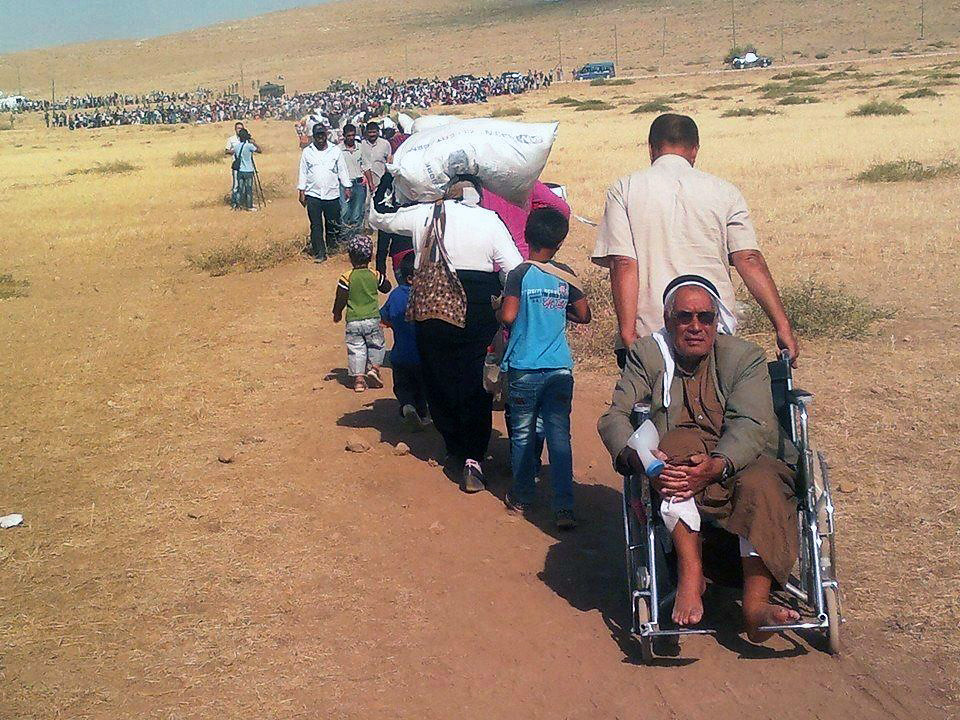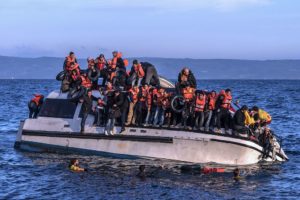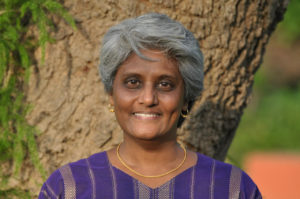
Upheaval and Migration – Part II
by Usha Alexander
[This is the ninth in a series of essays, On Climate Truth and Fiction, in which I raise questions about environmental distress, the human experience, and storytelling. It first appeared on 3 Quarks Daily. This ninth essay is divided into two parts. The eigth essay in the series, called “Views of Future Earth”, is here.]
The Next Great Human Migration
Humans are a migratory creature, by nature. Our time on Earth once saw families and whole communities roaming irrepressibly across open savannas, leaning hard into the blowing tundra, scaling snowy mountains and crossing jagged ranges, fording dense marshlands, even sailing edgeless expanses of ocean. For nearly three hundred thousand years of the human story, our ancestors were always on the move. They walked and walked. Ceaselessly. Until only a few thousand years ago—like yesterday, on an evolutionary timescale—when the stable Holocene climate and rising human population densities prompted the first settlements. Viewed against the long past, this new fashion of unbudging sedentism is anomalous human behavior.
But territorially defined nation-states abhor nomadism. So, during the centuries of European colonial expansion, the colonial powers did everything they could to destroy the lifestyles of nomadic peoples, forcing them to settle and work as laborers, through coercion and indoctrination. Increasing settlement, entrenching patriarchies, and the spread of the growth economy, aided by improved urban hygiene, facilitated human overpopulation to the point where there remain no more open lands to buffer migrations or absorb human displacements. In a very short period of time, we’ve built and ossified a world in which migration is utterly disruptive to how we live—to our politics, identities, social order. The disruption is felt by both the migrants, who lose everything, and by those asked to take them in, who fear the changes or the competition the newcomers will bring. Given the unfolding planetary changes, this is an unfortunate position we’ve backed ourselves into. Because people will be migrating once again in larger proportions.
According to data from the UN, the number of people who have been forcibly displaced from their homes from all causes has been steeply on the rise since 2012, increasing from forty-three to over seventy-nine million in 2019—that’s already over one percent of the people on the planet. A third of those are children. Of these, the vast majority were directly displaced by disasters, especially extreme weather events, based on data by the Internal Displacement Monitoring Centre of the Norwegian Refugee Council (IDMC). As people migrate to flee disaster, ethnic tensions are often inflamed, weakening economic and social institutions and sparking conflicts that displace millions more. Growing numbers of displaced people, mounting hunger, and rising sociopolitical conflict each exacerbate the other in a vicious cycle, so that displaced people are accruing faster than they can be rehabilitated.
In the years ahead, these numbers will rise further with the frequency and severity of disasters, overwhelming the capacity of humanitarian organizations. What happens when there are not just a hundred thousand people leaving barren farms and the ensuing local violence to gather at the southern border of the United States, but a million? When five million flee the killing heat of Western Asia for Eastern Europe? Or try to outrun the expanding Sahara Desert by crossing into Southern Europe—from there to Central and Northern Europe? When fifty million north Indians, Pakistanis, and Bangladeshis disperse in search of water, after their major river systems, fed by Himalayan glaciers, fade into streams? When a hundred million Southeast Asians abandon their coastal zones, their lands inundated by salt, their seas emptied of fish, their cities submerging? The UN High Commission for Refugees has stated that two hundred and fifty million climate refugees by 2050 is a conservative estimate; the UN International Organization for Migration cites estimates ranging as high as a billion people on the move by midcentury, depending on just how poorly things play out. Such displacements are far too big to be contained within national borders or answered with temporary aid. States will collapse; borders will get redrawn; other nations and communities will be called upon to provide support and make space to accommodate the desperate. And while such migrations won’t just erupt in a flash-mob one fine evening, it will behoove us to figure helpful responses now, as the problem relatively quietly accrues.
Under even the most optimistic scenarios, the numbers of people needing to relocate over the coming decades are bound to fracture our shallow notions of statehood and borders, let alone the governance of major cities where rural and small-town migrants will congregate. If we don’t find a way to accept and humanely manage mass migrations, they will shatter our very humanity too. The West already faced a great humanitarian challenge in 2015, when a million of those fleeing war in Syria sought refuge in Western nations, where their desperation stoked ethnic hatreds. Since then, we’ve seen the flimsy boats from North Africa, carrying refugees from across the Global South, capsize in the Mediterranean or get turned away at Italian ports. We’ve seen the deployment of US troops to the US-Mexican border where Central American children were caged like animals. All of these horrors will become memories of a simpler time, as pulses of impoverished people abandon desiccated fields or flee contests over water, sinking coastal zones, and lethally hot regions of the low latitudes, their fates wholly uncertain.
We might conceive of this as a new era of human migration, at a scale not seen in thousands of years, undertaken in a world no longer accommodating of it. It’s difficult not to imagine great waves of humanity on the move, pressing up against militarized borders possibly to be gunned down, turned away, or cast into refugee encampments. The tumbled and drowned refugees, the distressed camps, the caged children—these represent just a glimpse of the migrant tragedies yet to come. It’s in this context that I wonder at what point mass migrations might find the tipping point that upends our current geopolitical organization, or even our present globalized civilization.
Climatic and ecological breakdown is—above all—a humanitarian crisis. It’s about people losing their lands, their livelihoods, their communities and social support networks, their sense of security, their identities, their dreams for their future, their cultural and material inheritances, their lives. It is a matter of the profoundest upheaval, of change and resilience, of seeking answers as people ask, What happens after this? Our challenge is to protect people, especially the most vulnerable. If we’re approaching the problem humanely, those are the foundational matters that should lead—rather than merely result from—any technological fixes we allow to guide our politics. And yet, today there isn’t any legal recognition of a “climate refugee,” let alone a refugee from depleted fisheries or poisoned soils. Yet these matters should be a part of our conversations on environmental justice and climate change, no less than carbon taxes, battery technologies, and Green New Deals.

It’s often remarked that the ecological crises presently besetting the planet are primarily a problem for no one else but human beings. The Earth and its biome have undergone many phases, contractions, regrowths, altered states during its billions of years, and will continue to do so without us. All our present concern for the planet is premised upon maintaining the planetary status quo of the previous few thousand years and the continuance of the global industrial civilization we’ve built. But if we recognize that the way we presently live is unsustainable—and within sight of its own demise—that clinging to the status quo will only increase human suffering in the decades to come, what new incarnations of human civilization might we discover? Knowing everything we know of all the many social arrangements we humans have had, how might we embrace migration as a fundamental piece of civilizational adaptation for the future? If we are truly haunted by the specter of children in cages, if we are sincere in our concern for desperate people arriving on boats, in “caravans,” in the airless cargo holds of trucks, if we are worried about the chaos and conflict that can erupt when too many of us are left to wander in distress, then we cannot allow our respective governments to ignore the issue of mass migrations in addressing international climate negotiations and preparedness. And those of us in the climatically better-situated and wealthier nations must ready ourselves to take the migrants in.

Usha Alexander was born to Indian immigrants who came to the United States in the 1950s and settled in the very small town of Pocatello, Idaho. She ran away to university at the age of 19, and later joined the US Peace Corps, where she served as a science teacher in the archipelago nation of Vanuatu. In the late 90s, Usha made her way to the San Francisco Bay Area of California, where she settled and worked for Apple Computer for many years.
Since 2013, Usha resides with her partner, writer and photographer, Namit Arora, in the National Capital Region of India. Usha has lived in four different countries and has learned to carry her home within herself, yet she frequently returns to the CA Bay Area with a certain sense of homecoming.